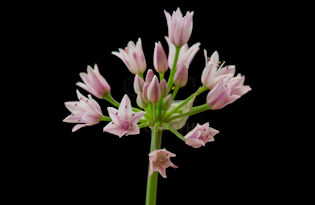|
Wild Onion
Wild Garlic
|

|
|
The plant strongly resembles long grass – in fact, I’ve stood in a field of it without realizing – until you inspect closer, or step on it just right, giving away its pungent scent. It has a rosette of basal leaves that grow up to 12 inches high, standing up right or slightly limp. These leaves are flat and skinny, with one fold down the center. They are smoother and lighter green than the common grass. Some leaves curl in the same way garlic does. These leaves grow from
an underground bulb, just like cultivated onion and garlic. The bulb is small, approximately .25-.5 inches, and has fibrous roots growing from the bottom. Each year, some plants produce an inflorescence that grows on a stiff, round stem. The inflorescence forms inside a thin, white bud with a pointed tip.
You can cut just the leaves, allowing the bulb to remain and keep growing, and use these the same way you would scallion or garlic greens. It is also possible to uproot the entire plant with a small tool. To cook with this bulb, first cut off the roots and then there is a brown outer skin that is easily removed. Cut the leaves off, and then chop the bulb. This can be sautéed alone in oil, just like chives or garlic would be. Add the greens later so they do not get overcooked. The bulbs can replace
garlic
in any recipe: stir fries, soups, spreads, you name it!
|
|
Health benefits
|
|
This plant is high in Vitamins A and C. It is also quite rich in potassium, calcium, manganese, and selenium.
It is believed that this plant is most closely related to cultivated garlic, which has many medicinal properties. It is effective at lowering bad cholesterol (LDL), while not changing good cholesterol (HDL) levels. Garlic widens blood arteries and decreases sticking of platelets, therefore lowering blood pressure and risk for blood clots. It is an antibiotic, killing bacteria, fungi, and other microbes, and can be used for bacterial diseases or
as a preventative method when you first feel a cold coming on.
|
|
|
|
|
|

